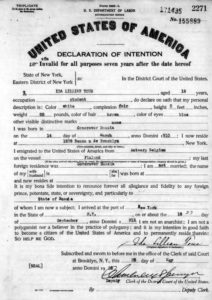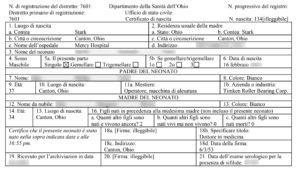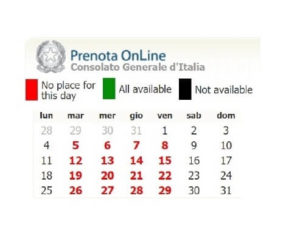
Obtaining Italian dual citizenship is a marathon, and not a sprint.
As Italian Americans, we are incredibly lucky in that Italy has some of the world’s most generous heritage citizenship laws. Operating on the principle of jure sanguinis (that’s Latin for “by right of blood”), Italy allows descendants of the Italian diaspora almost unrestricted access to obtaining Italian dual citizenship, provided that the applicant meet certain criteria.
While I will make a later post on how to determine if you qualify for Italian dual citizenship, I decided to concentrate this post on the concrete steps to take towards obtaining an Italian passport. (Edit: New for 2020, we have a nifty interactive quiz to determine if you qualify).
Before undertaking the project of obtaining Italian dual citizenship jure sanguinis, it is a good idea to be organized, well-informed and know what you are getting into. Thousands and thousand of people have obtained their passaporti already, but I find that many clients tell me they wish there were more information online presented in an organized way for them.
So, without further ado, here are 8 steps to obtaining Italian dual citizenship:
1. Determine – and work backwards from – your last Italian born ancestor

Think back to your last Italian born ancestor. What personal details do you know about him or her?
For reasons related to Italian citizenship law, it’s best if you start your research by thinking back to a paternal or male relative (women could not pass on Italian citizenship until January 1, 1948).
What do you know about him? Do you know where and when he was born in Italy and, if possible, his parents’ names?
If necessary, ask your family members for information. Remember, you’re looking for your last Italian-born ancestor before your family left Italy. When in doubt, consult our page here for information on researching your Italian roots.
If there are no male or paternal Italian relatives–don’t worry. You can still qualify for Italian dual citizenship; you just might have to go down a different path.
2. Obtain naturalization records

Using your ancestor’s name and date/place of birth, search for his or her naturalization record from the United States government. If your ancestor never naturalized, you must still search for these records. If they don’t exist, the government will send official paperwork to that effect. For the purposes of Italian dual citizenship, showing a paper trail of non-naturalization is important, too.
This is really important to remember: the date of naturalization is key.
Your ancestor’s date of naturalization is what will determine if you are eligible for citizenship.
In other words, if your last Italian born ancestor naturalized any time after his child’s birth, you may be eligible – with few exceptions.
For those exceptions, please refer to Italian citizenship laws pertaining to female ancestors and ancestors from Trentino Alto Adige, Veneto, and Friuli-Venezia-Giulia.
These regions were not automatically annexed to Italy at unification in 1861, so special rules pertain to those whose families come from these areas. Contact us for more information.
3. Obtain Italian vital records
Obtain the Italian birth certificate of the Italian ancestor through whom you are applying. If your ancestor got married in Italy, get the marriage record as well.
You may also need to get his/her spouse’s birth record so check with your consulate to be sure. Some will require it, and there is no one rule regarding “non-line” ancestors across the board.
4. Obtain American vital records
Check with your consulate’s website – or e-mail them if they respond to e-mails – and start to procure every U.S. document they require. You will need to obtain certified long form copies of all records (if in NYC, be sure to request a “letter of exemplification” for birth and death records), and will also need to apostille your records for use in Italy.
5. Apostille your American vital records for use in your Italian dual citizenship application
The purpose of an apostille is to make your non-Italian documents legal for use in Italy. It is a separate certification that the Secretary of State attaches to your records.
Be sure to check your consulate’s requirements to see which U.S. documents need further authentications, as requirements vary from consulate to consulate. Generally, all non-Italian documents except for naturalization records need apostilles.
If you need your documents to be apostilled for use in Italy, send the original records to the relevant US authority for authentication (most commonly the Secretary of State’s office in each state). Each state can only apostille documents issued there, so if your documents are from Georgia, get an apostille from Georgia, etc.
6. Translate your American documents into Italian. Use a translator well-versed in Italian dual citizenship.

Determine which records must be translated into Italian and have them professionally translated.
Not all consulates will require every single record to be translated, so make sure to look up your specific consulate’s rules regarding translations.
The importance of a professional translator cannot be understated. Unless you are completely fluent in Italian, you shouldn’t translate them. In this case, it’s prudent to hand off your vital records to someone who is experienced with English and Italian legal terminology.
We cannot stress this enough: a botched translation may cause you to lose your appointment and return months later.
7. Go to your Italian dual citizenship application at the consulate of your jurisdiction
Each adult applicant for Italian dual citizenship must be there in person at his or her appointment at the Italian consulate. The consular official will review all records and provide feedback if s/he cannot immediately determine eligibility. You may have to amend records, procure more records, re-translate, or cure any deficiencies in the eyes of the consulate.
For info on how to find your Italian consulate, click here.
8. Schedule your passport appointment

Once your Italian dual citizenship is recognized, some consulates will automatically enroll you in AIRE (the registry of Italians living abroad). Some others will require you contact them for registration in AIRE.
In either case, once you register as an Italian living abroad – as opposed to living in Italy – you can obtain an Italian passport. You can then schedule your passport appointment and obtain your passport when ready.
Note that if you want you can go to Italy, establish residency, and apply for your passport there instead of your consulate.
Also, fun fact: Italian consulates in the US will not issue you an Italian identity card (carta d’identità) but an Italian comune (town) will, as will Italian consulates within the EU.
But as always, you must be a resident of either jurisdiction before requesting a carta d’identità or passport.
[vcex_divider_dots color=”#dd3333″ margin_top=”10″ margin_bottom=”10″]
More helpful information for those seeking Italian dual citizenship
Finding your Italian ancestor’s date and place of birth
Suppose you want to get Italian dual citizenship. You’ve consulted with your family, are of Italian descent, and have a general idea that you have an Italian ancestor. However, you don’t know where he or she was born or if it’s your paternal or maternal ancestor. Your citizenship application will depend on having a complete set of documents so finding out this information is vital. Here’s how to find out your Italian ancestor’s date and place of birth so you can successfully prove your claim:
Let’s say your grandfather was born in the United States, but you think his father – your great grandfather – was from Italy and emigrated. Use Ancestry.com to search for census records including your grandfather. On the census records, you’ll see a column denoting whether or not all the people in his household had naturalized (aka, American citizens). You’ll find the name of your grandfather, his father, his mother, and of all other children in the family unit.
Then, take the name of your great grandfather as it appears on the census and search naturalization records on Ancestry.com. If you find something, you might be able to read the actual naturalization record pertaining to your Italian ancestor right there on the website! This would include the date and place of birth. If not, you now at least know your ancestor’s name. You can then can use that information to search the actual repositories for a hard copy of naturalization paperwork.
Here are some repositories you can check:
- NARA (National Archives and Records Administration),
- USCIS (United States Citizenship and Immigration Services),
- Local county clerks’ offices in the county your Italian ancestor lived.
[vcex_divider_dots color=”#dd3333″ margin_top=”10″ margin_bottom=”10″]
What to do if it’s hard to book an appointment at your Italian consulate
Obtaining recognition of Italian dual citizenship is one of your birth rights. For that reason, many people who qualify want to apply for their Italian passports. Each of the consular offices in the U.S. help approximately 3,000 people file claims yearly…. and it is said that each consulate in Brazil and Argentina see anywhere from 6,000-10,000 applications yearly.
There are so many applicants, and so little time!
As a result, it may take you a while to obtain an appointment and avail yourself of your rights. But what happens if you keep trying to get one and you simply can’t? You have two options:
Applying for dual citizenship in Italy
According to Italian law, foreign citizens of Italian descent must apply for recognition of citizenship jus sanguinis in the country where they reside. However, they can apply in Italy and bypass the consulate… as long as they obtain legal residence in Italy. So, if you are an American of Italian descent, you can travel to your ancestor’s country. Then, you can stake your claim in the town where you establish your new home base. Remember, however, that the town has up to 45 days to verify your residency first.
Taking your claim to court
What if you can’t spend time in Italy (or you simply don’t want to), but you also can’t get a consular appointment? You can take your case to court. If you have been trying to get an appointment and it is impossible, you can hire an attorney to represent you in court and seek recognition this way. In this manner, you would be bypassing the consulate which has failed to let you exercise your rights as an Italian citizen to seek recognition of your [latent] citizenship. We can help.
[vcex_divider_dots color=”#dd3333″ margin_top=”10″ margin_bottom=”10″]
How long does it take to get Italian dual citizenship?
The time it takes to process your application depends on a number of factors, but it can take anywhere from 6 to 24 months for processing from the moment you hand in your documents.
We have a post on the subject of processing times here.
[vcex_divider_dots color=”#dd3333″ margin_top=”10″ margin_bottom=”10″]
Why would you even want to get an Italian passport?
Simply put, your lineage will open up the world to you. Thanks to jus sanguinis, you can live, work, and study anywhere in the European Union (28 in all). Additionally, Italian citizens receive free to low cost healthcare and affordable education.
[vcex_divider_dots color=”#dd3333″ margin_top=”10″ margin_bottom=”10″]
We can help you!
Since 2005, Get Italian Citizenship, Inc. has helped hundreds of Italian Americans (and people of Italian descent from all over the world) obtain their Italian passports. Our services include translations, document procurement, and full service applications both at the consulate(s) and directly in Italy.
